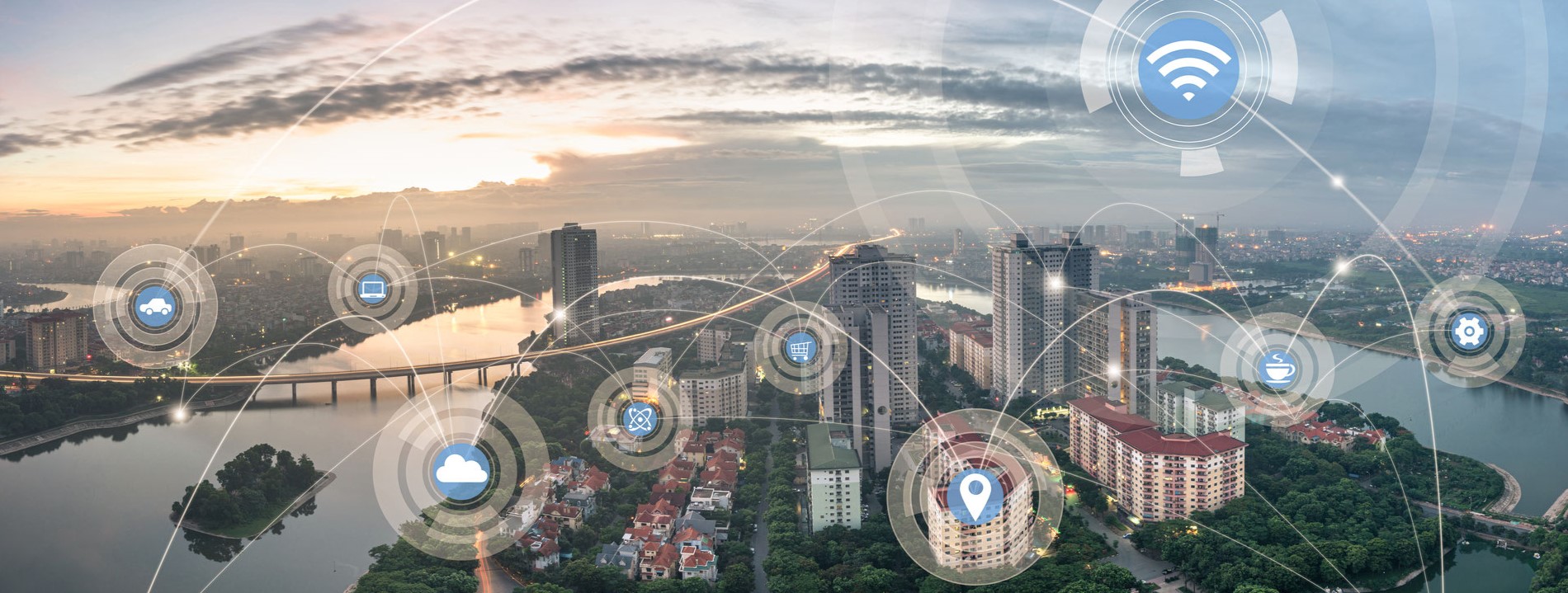Thanks to the Fridays for Future movement, climate change and the urgent need for action have entered the consciousness of even more people. The pressure on politicians and responsible actors in the energy sector and other areas is increasing. But how can an effective energy transition succeed in the future “smart cities”? In the following, we show how a virtual power plant can drive the energy transition in conurbations, reducing additional work for plant operators, saving costs and generating profitable additional revenues at the same time.
Digital platforms – the energy system of the future in fully networked cities?
The smart city needs many solutions: Building automation, e-government, autonomous driving, 5G, public transport, smart factory, smart home and even charging e-scooters – but also a sustainable decentralised energy supply. The energy transition is a must. And for its implementation, new and fast-acting strategies are urgently needed. This requires a rethink and decisive action across the entire energy market.
But what do innovative models in the industry look like?
How can smaller plant operators and companies also act professionally and economically and further and reliably expand the energy transition? How can energy bottlenecks in the supply be avoided at the same time? What role does digitalisation play?
One thing is certain: the German energy market is already undergoing a power plant turnaround. Coal and nuclear power plants are being phased out. Practical tests show that a full supply of renewable energies is realistic and that large power plants can be replaced. With the energy transition, the number of decentralised, renewable generation plants is steadily increasing. They all have to ensure security of supply, economic efficiency and sustainability. These decentralised plants must therefore be intelligently and efficiently networked and controlled. Challenges of a new generation of power plants that have to be mastered.
Sustainable energy supply in the green city
In a nutshell: The digitalisation platform itself is not an electricity producer. It combines decentralised, smaller energy systems such as combined heat and power plants, wind, water and solar systems into a networked, flexibly adjustable and centrally controlled system (building management). This involves an extremely high IT effort. The information from all the connected systems comes together in the control system. With the help of a separate computer centre, as with BentoNet, the data is coordinated in real time. They provide information about the utilisation status of each individual plant and calculate forecasts for possible energy fluctuations. This sensitive data communication takes place with the support of particularly secure connections.
Controllable plants such as hydropower plants, CHPs or emergency generators play a special role in the energy transition. In the event of an oversupply of electricity, they can on the one hand throttle or interrupt their production (negative control energy) and on the other feed additional electricity (positive control energy) into the grid in the event of an electricity shortage. Tenant power solutions can also be realised in this way, with which tenants can benefit directly from the sustainable and cheap electricity of the decentralised plants – keyword Smart Factory.
What can a digital platform do?
The purpose of a platform is mainly the joint marketing of electricity and flexible and reliable access to power from the aggregated plants at any time. The particular strength of a shared infrastructure is its rapid adaptability. This flexibility – a clear differentiator from traditional large-scale power plants, by the way – enables adaptable trading on the exchange to market the generated electricity profitably.
How viable are platforms as business models in the energy market of the future?
Renewable energies are land-intensive. Their production will take place outside the urban centres. Therefore, the energy market of the future will be determined by virtual power plants in smart cities.
Digital technologies help to network the connected plants in a meaningful way and to process the data sustainably. A flood of information hits the infrastructure on site every minute; analogue calculation is impossible. So digitalisation has already successfully made its way here. In the future, the energy market will be dominated by decentralised power generation and battery storage technologies, and the further development of intelligent networking will be forced. The Internet of Things (IoT) will also play a major role in this. Examples of this are charging management and load distribution in e-mobility. There is no chance of a successful energy transition without digitalisation. Optimal asset management ensures climate-friendly electricity and is certainly up to the challenge of digitalisation.
With a stake in a digital platform, plant operators also have access to various markets. They can have their electricity traded on the exchange or contribute to reliable utilisation via the balancing energy market. The goal for the operator must be to generate positive strategic and business effects.
IoT platforms with TSO compliance such as BentoNet offer operators security of supply, efficient and transparent plant operation with energy management, greater economic efficiency, workload reduction and – last but not least – the opportunity to make an active contribution to climate protection. It is simple, fast, secure and cost-effective.






